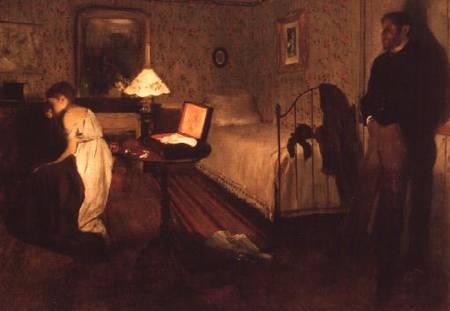
Interior (The Rape) by Edgar Degas, 1868-9
In the fall semester of my junior year I took an art history course entitled Theory and Criticism. On the first day of class our professor told us that this was in fact the hardest course within the major and essentially we would be teaching ourselves the material (via torturous hour long weekly presentations by every student in the class for the next 3 and a half months). Hundreds and hundreds of pages of scholarly articles later on topics I didn't even know could be applied to art history brought the class to the painting you see above. It has almost been three years since I discussed this piece in depth, and it is still fresh in my mind. The startled feeling I get right where both sides of my ribcage meet each other remains and I am stunned.
Degas is obviously a well known painter, but most importantly among the laymen his named strikes a particular key. Thick and colorful images of ballerinas in formation with one another come to mind and the delicacy with which the paint was applied to such supple canvases reminds us of Impressionism -- one of the most revered and respected movements in art. The part of our brain that stores pictures is triggered and releases Monet's waterlilies, Manet's seascapes, and the faces of the many Renoir children. The goal of this "glamorous" high painting was light, to capture it and maintain it in the most realistic of ways throughout the entire piece. An even balance of luminous color is cast upon the canvas using apparent brush strokes, clearly not as striking as the Expressionistic application seen in such Van Goghs but still powerful. Artists working within this spectrum wanted to give the impression of the ideal. They were working their way out of Realism, and Impressionism was the best way to give a realistic depiction of a world that was only perfect on the outside, which brings us to Degas' The Rape. Here we are reminded that no matter how many idyllic flower scenes and bourgeois French citizens an artist focuses on there is a dark, frightening mind within that realizes not all is as it seems.
Remember that Impressionism shows that everything seems fine on the outside, well, this is the antithesis of that. This concept is not proven by examining the darkness of the scene, nor is the woman's torn dress or the positioning of the man against the wall a true hint to the obscurity of private lives. It's in the tilted and warped perspective, the focal point, and the sheer uncertainty of the presentation that makes us question our own realities. Every formal aspect of this painting leads the viewer to believe that the situation we are first presented with may not be as it seems. It is said that this scene is based on a Zola story, one of a woman who wants her lover to kill her husband so they can elope and live together. If this is known ahead of time, one could speculate that the man (who we initially perceive as the rapist) has arrived to his lover's bedroom after killing her husband. She waits anxiously for his return, the torn dress symbolically representing her torn conscience. Light as the central focus could have been used in this instance to set the figures apart from the viewer, placing them in a lower moral caliber than us. But perhaps the picture is telling us exactly what we are told, and the Degas has manipulated the light to place the woman in a vulnerable position, she is in fact crouched and set below the male figure who is in "power". Whether we are witnessing a raw love born from infidelity or an innocence that has been ripped from one person by another, this unsettling image is what I believe to be the epitome of Impressionism (at its highest).
It is ideas such as these that I believe inspired Neo-Impressionists like Georges Seurat to fragment reality and give the viewer an image that is admired and confusing -- showing us familiarity and ripping it away by manipulating a site so that it is looked upon in a way that at one point was inconceivable. The Gravelines done by Seurat at the fin-de-siecle are a perfect example of this. Such dizzying pieces remind us of the Night Cafe by Vincent Van Gogh and how the prettiness of painting done un plein air is in fact underrated.


2 comments:
funny how you mention degas' use of light--my favorites of his, beyond all of the tulle, are the paintings from the vantage point of the orchestra. i find the use of light in those pieces to be captivating. what you introduce here on the subject will make me all the more interested and aware in viewings to come.
lovely.
http://bp0.blogger.com/_padj5QNAQiY/RdApU6QHX4I/AAAAAAAAACo/Lb7Aq09xS3s/s1600-h/degas+musicians.jpg
Post a Comment